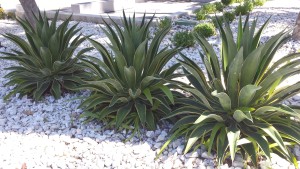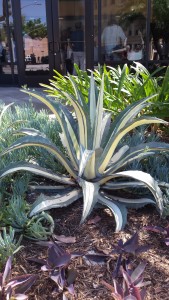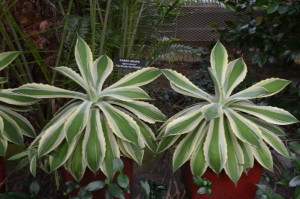Agaves (Agave spp.) are long-leaved succulent landscape plants. These native perennial succulents grow in desert-like environments (USDA hardiness zones 8 and warmer). Plants grow in a rosette form with long their fleshy leaves frequently tipped with one or more sharp spines and a prominent bloom spike with cup shaped flowers. Most are native to the Southwest U.S. and Mexico.
Agaves are exceptionally drought tolerant and ideal for xeric gardens. Temperature hardiness, sunlight, and soil drainage are the three key components to successfully growing agaves. Agave have a large tap root and do not transplant well, so carefully select an appropriate site where to plant. The majority of the roots are surface roots and do not require a deep hole if planted when young.
Porous, well-drained soil is an absolute must! When planting in clay soils, deeply amend bed or container soil with coarse sand or pea gravel in a 50:50 ratio. Water the plant diligently the first week after planting and gradually wean it back to 2-3 times monthly in containers, all depending on season of the year and outdoor air temps.
Never overwater agaves! They are famous for their low water use. In early spring apply a slow release fertilizer such as Osmocote™ or Nutrikote™. This should supply nutrient needs for the entire year.
Most agaves naturally dieback after blooming. They form new plants (“pups” or offshoots) at the base of the “mother” plant. Many gardeners opt to remove the spent floral spike with long handle lopper pruners to avoid their sharp spines. Agaves should be re-potted every year, usually in the spring in new media. Prune off old lower leaves if they detract from the plant’s beauty.
Non-hardy types are moved indoors or in an unheated garage where temps drop below 37°F and grown in an east facing window. Over the winter months reduce frequency of watering intervals and do not fertilize.
Agaves are deer-resistant. The tall bloom stalks attract hummingbirds.
Four popular agaves:
Century plant (Agave americana) – a lovely flower (inflorescence) and leaves have a white stripe running along the center.
Parry’s or Mescal agave (Agave parryi) – an attractive slow growing compact form that measures 2-3 feet across. Leaves are grey green tipped with a spine (zone 7 hardy).
Ocahui Century Plant (Agave ocahui ) (zone 7b -10) – this 2-3 feet wide ball-shaped agave has attractive rigid dark green leaf blades with attractive red margins and sharp flexible spines. Bloom spike will eventually reach nearly 15 feet tall with yellow-green flowers.
Black spine agave (Agave macroacantha) – a medium sized rosette form and 1 ½ feet long thick grey green leaves, each tipped with a 1-inch long sharp black spine. Small grey and red flowers form on sturdy 7-10 feet high stems.




 Posted in
Posted in 
